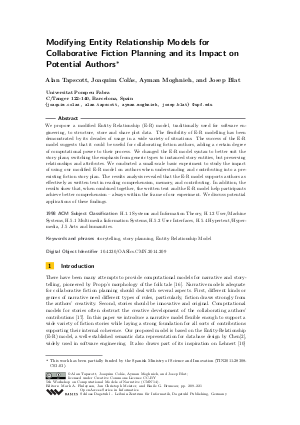Modifying Entity Relationship Models for Collaborative Fiction Planning and its Impact on Potential Authors
Authors Alan Tapscott, Joaquim Colàs, Ayman Moghnieh, Josep Blat
-
Part of:
Volume:
2014 Workshop on Computational Models of Narrative (CMN 2014)
Part of: Series: Open Access Series in Informatics (OASIcs) - License:
 Creative Commons Attribution 3.0 Unported license
Creative Commons Attribution 3.0 Unported license
- Publication Date: 2014-08-08
File

PDF
OASIcs.CMN.2014.209.pdf
- Filesize: 0.78 MB
- 13 pages
Document Identifiers
Subject Classification
Keywords
- storytelling
- story planning
- Entity Relationship Model
Metrics
- Access Statistics
-
Total Accesses (updated on a weekly basis)
0PDF Downloads0Metadata Views
Abstract
We propose a modified Entity Relationship (E-R) model, traditionally used for software engineering, to structure, store and share plot data. The flexibility of E-R modelling has been demonstrated by its decades of usage in a wide variety of situations. The success of the E-R model suggests that it could be useful for collaborating fiction authors, adding a certain degree of computational power to their process. We changed the E-R model syntax to better suit the story plans, switching the emphasis from generic types to instanced story entities, but preserving relationships and attributes. We conducted a small-scale basic experiment to study the impact of using our modified E-R model on authors when understanding and contributing into a pre-existing fiction story plan. The results analysis revealed that the E-R model supports authors as effectively as written text in reading comprehension, memory, and contributing. In addition, the results show that, when combined together, the written text and the E-R model help participants achieve better comprehension--always within the frame of our experiment. We discuss potential applications of these findings.
Cite As Get BibTex
Alan Tapscott, Joaquim Colàs, Ayman Moghnieh, and Josep Blat. Modifying Entity Relationship Models for Collaborative Fiction Planning and its Impact on Potential Authors. In 2014 Workshop on Computational Models of Narrative. Open Access Series in Informatics (OASIcs), Volume 41, pp. 209-221, Schloss Dagstuhl – Leibniz-Zentrum für Informatik (2014)
https://doi.org/10.4230/OASIcs.CMN.2014.209
BibTex
@InProceedings{tapscott_et_al:OASIcs.CMN.2014.209,
author = {Tapscott, Alan and Col\`{a}s, Joaquim and Moghnieh, Ayman and Blat, Josep},
title = {{Modifying Entity Relationship Models for Collaborative Fiction Planning and its Impact on Potential Authors}},
booktitle = {2014 Workshop on Computational Models of Narrative},
pages = {209--221},
series = {Open Access Series in Informatics (OASIcs)},
ISBN = {978-3-939897-71-2},
ISSN = {2190-6807},
year = {2014},
volume = {41},
editor = {Finlayson, Mark A. and Meister, Jan Christoph and Bruneau, Emile G.},
publisher = {Schloss Dagstuhl -- Leibniz-Zentrum f{\"u}r Informatik},
address = {Dagstuhl, Germany},
URL = {https://drops.dagstuhl.de/entities/document/10.4230/OASIcs.CMN.2014.209},
URN = {urn:nbn:de:0030-drops-46588},
doi = {10.4230/OASIcs.CMN.2014.209},
annote = {Keywords: storytelling, story planning, Entity Relationship Model}
}
Author Details
References
-
Selmer Bringsjord and David Ferrucci. Artificial intelligence and literary creativity: Inside the mind of brutus, a storytelling machine. Psychology Press, 1999.

-
Peter Pin-Shan Chen. The entity-relationship model—toward a unified view of data. ACM Transactions on Database Systems (TODS), 1(1):9-36, 1976.

-
Peter Pin-Shan Chen. English sentence structure and entity-relationship diagrams. Information Sciences, 29(2):127-149, 1983.

-
Joaquim Colas, Alan Tapscott, Ayman Moghnieh, and Josep Blat. Shared narratives as a new interactive medium: Crosstale as a prototype for collaborative storytelling. International Journal On Advances in Telecommunications, 6(1 and 2):12-23, 2013.

-
Steven R. Corman, B. Hunter Ball, Kimberly M. Talboom, and Gene A. Brewer. Assessing Two-Mode Semantic Network Story Representations Using a False Memory Paradigm. In Mark A. Finlayson, Bernhard Fisseni, Benedikt Löwe, and Jan Christoph Meister, editors, 2013 Workshop on Computational Models of Narrative, volume 32 of OpenAccess Series in Informatics (OASIcs), pages 53-61, Dagstuhl, Germany, 2013. Schloss Dagstuhl-Leibniz-Zentrum fuer Informatik.

-
Sven Hartmann and Sebastian Link. English sentence structures and eer modeling. In Proceedings of the fourth Asia-Pacific conference on Comceptual modelling-Volume 67, pages 27-35. Australian Computer Society, Inc., 2007.

-
Jos Kirps. Galaxiki, 2007. [Online; accessed 30-May-2014].

-
Manfred R. Klopprogge. Term: An approach to include time dimension in the entity-relationship model. In Proceedings of the Second International Conference on the Entity-Relationship Approach to Information Modeling and Analysis, ER '81, pages 473-508, Amsterdam, The Netherlands, The Netherlands, 1983. North-Holland Publishing Co.

-
Michael Lebowitz. Creating a story-telling universe. Technical report, Department of Computer Science, Columbia University, 1983.

-
Wendy G Lehnert. Plot units and narrative summarization. Cognitive Science, 5(4):293-331, 1981.

-
Peter Likarish and Jon Winet. Exquisite corpse 2.0: qualitative analysis of a community-based fiction project. In Proceedings of the Designing Interactive Systems Conference, pages 564-567. ACM, 2012.

-
Paul Benjamin Lowry, Aaron Curtis, and Michelle René Lowry. Building a taxonomy and nomenclature of collaborative writing to improve interdisciplinary research and practice. Journal of Business Communication, 41(1):66-99, 2004.

-
Richard E Mayer. Multimedia learning. Cambridge university press, 2009.

-
John C Nesbit and Olusola O Adesope. Learning with concept and knowledge maps: A meta-analysis. Review of educational research, 76(3):413-448, 2006.

-
Joan Peckham and Fred Maryanski. Semantic data models. ACM Computing Surveys (CSUR), 20(3):153-189, 1988.

-
Vladimir Propp. The Morphology of the Folktale. University of Texas Press, Austin, 1968.

-
Alan Tapscot, Joaquim Colàs, Ayman Moghnieh, and Josep Blat. Writing Consistent Stories based on Structured Multi-Authored Narrative Spaces. In Mark A. Finlayson, Bernhard Fisseni, Benedikt Löwe, and Jan Christoph Meister, editors, 2013 Workshop on Computational Models of Narrative, volume 32 of OpenAccess Series in Informatics (OASIcs), pages 277-292, Dagstuhl, Germany, 2013. Schloss Dagstuhl-Leibniz-Zentrum fuer Informatik.

-
Wikipedia. La diligencia - Wikipedia, the free encyclopedia, 1939. [Online; accessed 30-May-2014].

